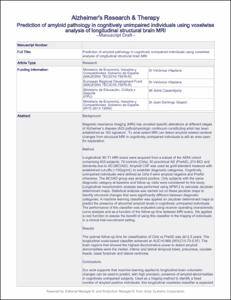Mostra el registre d'ítem simple
Prediction of amyloid pathology in cognitively unimpaired individuals using voxel-wise analysis of longitudinal structural brain MRI
| dc.contributor.author | Petrone, Paula |
| dc.contributor.author | Casamitjana Díaz, Adrià |
| dc.contributor.author | Falcón, Carlos |
| dc.contributor.author | Artigues, Miquel |
| dc.contributor.author | Operto, Grégory |
| dc.contributor.author | Cacciaglia, Raffaele |
| dc.contributor.author | Molinuevo, José Luis |
| dc.contributor.author | Vilaplana Besler, Verónica |
| dc.contributor.author | Gispert, Juan Domingo |
| dc.contributor.other | Universitat Politècnica de Catalunya. Doctorat en Teoria del Senyal i Comunicacions |
| dc.contributor.other | Universitat Politècnica de Catalunya. Departament de Teoria del Senyal i Comunicacions |
| dc.date.accessioned | 2020-01-24T18:46:45Z |
| dc.date.available | 2020-01-24T18:46:45Z |
| dc.date.issued | 2019-08-17 |
| dc.identifier.citation | Petrone, P. [et al.]. Prediction of amyloid pathology in cognitively unimpaired individuals using voxel-wise analysis of longitudinal structural brain MRI. "Alzheimers Research & Therapy", 17 Agost 2019, vol. 11, núm. 72, p. 1-13. |
| dc.identifier.issn | 1758-9193 |
| dc.identifier.uri | http://hdl.handle.net/2117/175733 |
| dc.description.abstract | Background Magnetic resonance imaging (MRI) has unveiled specific alterations at different stages of Alzheimer’s disease (AD) pathophysiologic continuum constituting what has been established as “AD signature”. To what extent MRI can detect amyloid-related cerebral changes from structural MRI in cognitively unimpaired individuals is still an area open for exploration. Method Longitudinal 3D-T1 MRI scans were acquired from a subset of the ADNI cohort comprising 403 subjects: 79 controls (Ctrls), 50 preclinical AD (PreAD), and 274 MCI and dementia due to AD (MCI/AD). Amyloid CSF was used as gold-standard measure with established cutoffs (<¿192¿pg/mL) to establish diagnostic categories. Cognitively unimpaired individuals were defined as Ctrls if were amyloid negative and PreAD otherwise. The MCI/AD group was amyloid positive. Only subjects with the same diagnostic category at baseline and follow-up visits were considered for the study. Longitudinal morphometric analysis was performed using SPM12 to calculate Jacobian determinant maps. Statistical analysis was carried out on these Jacobian maps to identify structural changes that were significantly different between diagnostic categories. A machine learning classifier was applied on Jacobian determinant maps to predict the presence of abnormal amyloid levels in cognitively unimpaired individuals. The performance of this classifier was evaluated using receiver operating characteristic curve analysis and as a function of the follow-up time between MRI scans. We applied a cost function to assess the benefit of using this classifier in the triaging of individuals in a clinical trial-recruitment setting. Results The optimal follow-up time for classification of Ctrls vs PreAD was ¿t¿>¿2.5¿years, and hence, only subjects within this temporal span are used for evaluation (15 Ctrls, 10 PreAD). The longitudinal voxel-based classifier achieved an AUC¿=¿0.87 (95%CI 0.72–0.97). The brain regions that showed the highest discriminative power to detect amyloid abnormalities were the medial, inferior, and lateral temporal lobes; precuneus; caudate heads; basal forebrain; and lateral ventricles. Conclusions Our work supports that machine learning applied to longitudinal brain volumetric changes can be used to predict, with high precision, the presence of amyloid abnormalities in cognitively unimpaired subjects. Used as a triaging method to identify a fixed number of amyloid-positive individuals, this longitudinal voxel-wise classifier is expected to avoid 55% of unnecessary CSF and/or PET scans and reduce economic cost by 40%. |
| dc.format.extent | 13 p. |
| dc.language.iso | eng |
| dc.rights | Attribution-NonCommercial-NoDerivs 3.0 Spain |
| dc.rights.uri | http://creativecommons.org/licenses/by-nc-nd/3.0/es/ |
| dc.subject | Àrees temàtiques de la UPC::Informàtica::Intel·ligència artificial::Aprenentatge automàtic |
| dc.subject | Àrees temàtiques de la UPC::Ciències de la salut::Medicina::Diagnòstic per la imatge |
| dc.subject.lcsh | Machine learning |
| dc.subject.lcsh | Alzheimer’s disease -- Diagnosis |
| dc.subject.other | Preclinical AD signature |
| dc.subject.other | Jacobian determinant |
| dc.subject.other | MRI |
| dc.subject.other | Machine learning |
| dc.subject.other | Longitudinal voxel-wise analysis |
| dc.title | Prediction of amyloid pathology in cognitively unimpaired individuals using voxel-wise analysis of longitudinal structural brain MRI |
| dc.type | Article |
| dc.subject.lemac | Aprenentatge automàtic |
| dc.subject.lemac | Alzheimer, Malaltia d' -- Diagnòstic |
| dc.contributor.group | Universitat Politècnica de Catalunya. GPI - Grup de Processament d'Imatge i Vídeo |
| dc.identifier.doi | 10.1186/s13195-019-0526-8 |
| dc.description.peerreviewed | Peer Reviewed |
| dc.relation.publisherversion | https://alzres.biomedcentral.com/articles/10.1186/s13195-019-0526-8 |
| dc.rights.access | Open Access |
| local.identifier.drac | 25820220 |
| dc.description.version | Postprint (published version) |
| dc.relation.projectid | info:eu-repo/grantAgreement/MINECO/1PE/TEC2016-75976-R |
| local.citation.author | Petrone, P.; Casamitjana, A.; Falcón, C.; Artigues, M.; Operto, G.; Cacciaglia, R.; Molinuevo, J.; Vilaplana, V.; Gispert, J. D. |
| local.citation.publicationName | Alzheimers Research & Therapy |
| local.citation.volume | 11 |
| local.citation.number | 72 |
| local.citation.startingPage | 1 |
| local.citation.endingPage | 13 |
Fitxers d'aquest items
Aquest ítem apareix a les col·leccions següents
-
Articles de revista [2.526]
-
Articles de revista [211]
-
Articles de revista [118]


